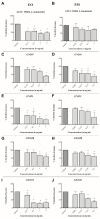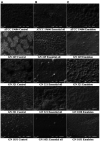Cinnamon essential oil and its emulsion as efficient antibiofilm agents to combat Acinetobacter baumannii
- PMID: 36299724
- PMCID: PMC9589355
- DOI: 10.3389/fmicb.2022.989667
Cinnamon essential oil and its emulsion as efficient antibiofilm agents to combat Acinetobacter baumannii
Abstract
Acinetobacter baumannii is an emerging nosocomial pathogen resistant to a wide spectrum of antibiotics, with great potential to form a biofilm, which further aggravates treatment of infections caused by it. Therefore, searching for new potent agents that are efficient against A. baumannii seems to be a necessity. One of them, which has already been proven to possess a wide spectrum of biological activities, including antimicrobial effect, is cinnamon essential oil. Still, further increase of antibacterial efficacy and improvement of bioavailability of cinnamon oil is possible by emulsification process. The aim of this study was comparative analysis of cinnamon essential oil and its emulsion against biofilm forming A. baumannii clinical isolates. Furthermore, the investigation of toxicological aspects of possible applications of essential oil and emulsion was done as well. Gas chromatography-mass spectrometry of essential oil indicated trans-cinnamaldehyde as the most abundant component. The cinnamon emulsion was synthesized from cinnamon essential oil by combining modified low- and high- energy methods. Synthesized emulsion was characterized with Fourier-transform infrared spectroscopy and photon correlation spectroscopy. Both substances exhibited significant antibacterial (minimal inhibitory concentrations in the range 0.125-0.5 mg/ml) and antibiofilm effects (inhibitions of formation and reduction of pre-formed biofilm were 47-81 and 30-62%, respectively). Compared to essential oil, the efficacy of emulsion was even stronger considering the small share of pure oil (20%) in the emulsion. The result of biofilm eradication assay was confirmed by scanning electron microscopy. Even though the cytotoxicity was high especially for the emulsion, genotoxicity was not determined. In conclusion, strong antibacterial/antibiofilm effect against A. baumannii of the cinnamon essential oil and the fact that emulsification even potentiated the activity, seems to be of great significance. Observed cytotoxicity implicated that further analysis is needed in order to clearly determine active principles being responsible for obtained antibacterial/antibiofilm and cytotoxic properties.
Keywords: Acinetobacter; antibacterial; biofilm; cinnamon; cytotoxicity; emulsion; essential oil; genotoxicity.
Copyright © 2022 Ganić, Vuletić, Nikolić, Stevanović, Kuzmanović, Kekić, Đurović, Cvetković and Mitić-Ćulafić.
Conflict of interest statement
The authors declare that the research was conducted in the absence of any commercial or financial relationships that could be construed as a potential conflict of interest.
Figures








Similar articles
-
Evaluation of Cinnamon Essential Oil and Its Emulsion on Biofilm-Associated Components of Acinetobacter baumannii Clinical Strains.Antibiotics (Basel). 2025 Jan 19;14(1):106. doi: 10.3390/antibiotics14010106. Antibiotics (Basel). 2025. PMID: 39858391 Free PMC article.
-
Cinnamon Oil-Loaded Nanoliposomes with Potent Antibacterial and Antibiofilm Activities.Molecules. 2023 Jun 1;28(11):4492. doi: 10.3390/molecules28114492. Molecules. 2023. PMID: 37298980 Free PMC article.
-
Effect of cinnamon (Cinnamomum verum) bark essential oil on the halitosis-associated bacterium Solobacterium moorei and in vitro cytotoxicity.Arch Oral Biol. 2017 Nov;83:97-104. doi: 10.1016/j.archoralbio.2017.07.005. Epub 2017 Jul 12. Arch Oral Biol. 2017. PMID: 28743086
-
Therapeutic Potential of Cinnamon Oil: Chemical Composition, Pharmacological Actions, and Applications.Pharmaceuticals (Basel). 2024 Dec 17;17(12):1700. doi: 10.3390/ph17121700. Pharmaceuticals (Basel). 2024. PMID: 39770541 Free PMC article. Review.
-
Therapeutic strategies against potential antibiofilm targets of multidrug-resistant Acinetobacter baumannii.J Cell Physiol. 2022 Apr;237(4):2045-2063. doi: 10.1002/jcp.30683. Epub 2022 Jan 26. J Cell Physiol. 2022. PMID: 35083758 Review.
Cited by
-
Evaluation of Cinnamon Essential Oil and Its Emulsion on Biofilm-Associated Components of Acinetobacter baumannii Clinical Strains.Antibiotics (Basel). 2025 Jan 19;14(1):106. doi: 10.3390/antibiotics14010106. Antibiotics (Basel). 2025. PMID: 39858391 Free PMC article.
-
Synergistic Antibiofilm Action of Cinnamomum verum and Brazilian Green Propolis Hydroethanolic Extracts against Multidrug-Resistant Strains of Acinetobacter baumannii and Pseudomonas aeruginosa and Their Biocompatibility on Human Keratinocytes.Molecules. 2023 Oct 1;28(19):6904. doi: 10.3390/molecules28196904. Molecules. 2023. PMID: 37836747 Free PMC article.
-
The Influence of Physical Fields (Magnetic and Electric) and LASER Exposure on the Composition and Bioactivity of Cinnamon Bark, Patchouli, and Geranium Essential Oils.Plants (Basel). 2024 Jul 21;13(14):1992. doi: 10.3390/plants13141992. Plants (Basel). 2024. PMID: 39065519 Free PMC article.
-
Natural compounds for colistin-resistant Acinetobacter baumannii biofilm control: eugenol, cinnamaldehyde, and carvacrol.Mol Biol Rep. 2025 Jul 18;52(1):735. doi: 10.1007/s11033-025-10844-1. Mol Biol Rep. 2025. PMID: 40679553 No abstract available.
-
Microemulsions of clove, tea tree and cinnamon using different tweens: physical properties and antimicrobial activity against E. coli O157:H7.J Food Sci Technol. 2025 Apr;62(4):680-686. doi: 10.1007/s13197-024-06056-3. Epub 2024 Sep 25. J Food Sci Technol. 2025. PMID: 40109685
References
-
- Aumeeruddy-Elalfi Z., Ismaël I. S., Hosenally M., Zengin G., Mahomoodally M. F. (2018). Essential oils from tropical medicinal herbs and food plants inhibit biofilm formation in vitro and are non-cytotoxic to human cells. 3 Biotech 8, 395–311. doi: 10.1007/s13205-018-1413-x, PMID: - DOI - PMC - PubMed
-
- Barradas T. N., de Holanda e Silva K. G. (2021). Nanoemulsions of essential oils to improve solubility, stability and permeability: a review. Environ. Chem. Lett. 19, 1153–1171. doi: 10.1007/s10311-020-01142-2 - DOI
LinkOut - more resources
Full Text Sources
Molecular Biology Databases

